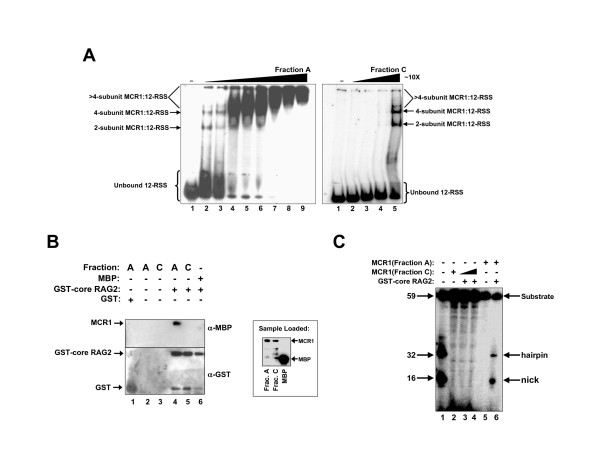Figure 4.
Dimeric MCR1, but not the octameric form, can maintain RAG1 related unctions. (A) Electrophoretic mobility shift assay demonstrating the interaction of MCR1 (Fraction A and Fraction C) with double-stranded WT 12-RSS. The radiolabeled substrate was titrated with increasing concentrations of either Fraction A (which was predominantly dimeric MCR1) or Fraction C (which was predominantly octameric MCR1). The protein concentrations ranged from 0.05 to 1 μM (lanes 2 to 9 for Fraction A) and 0.5 to 5 μM (lanes 2 to 5 for Fraction C). The samples were subjected to electrophoresis on a discontinuous (3.5/8%), non-denaturing polyacrylamide gel. Protein-DNA complexes consisting of either 2, 4, or >4 subunits of MCR1 bound to the 12-RSS are denoted by arrows. (B) Interaction between RAG2 and MCR1 (Fraction A and C). GST-core RAG2 (lanes 4–6) or GST (lane 1) was bound to glutathione-sepharose resin in the presence of MCR1 Fraction A (and in some cases Fraction C). The proteins eluted from the resin were resolved by SDS-PAGE and electrotransferred to polyvinylidene difluoride membranes. Left Panel: The interaction of GST and GST-core RAG2 with the glutathione resin was confirmed by the α-GST Western analysis blots. MCR1 fractions that interacted with GSTcore RAG2 are demonstrated by the α-MBP Western blot. Right Panel: α-MBP Western blot of Fractions A and C (lanes 1 and 2) and MBP (lane 3) at the loading concentrations used in the pull down assay. (C) DNA cleavage activity of MCR1 Fraction A and C. The proteins used are indicated above each lane. Radiolabeled double-stranded WT 12-RSS was incubated with MCR1 fractions and GST-core RAG2. DNA products were resolved on a 10% denaturing polyacrylmide gel. The protein concentrations were 10 μg/ml and 40 μg/ml (lanes 2, 3 and 4 for Fraction C) and 10 μg/ml (lane 5 and 6 for Fraction A). Concentration of GST-RAG2 used was 10 μg/ml. The reactions were in 5 mM Mn2+. The hairpin and nicked products are labeled. The percentages of nick and hairpin products relative to the total DNA in lane 6 were quantified at 16% and 6%, respectively.

